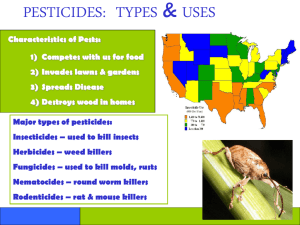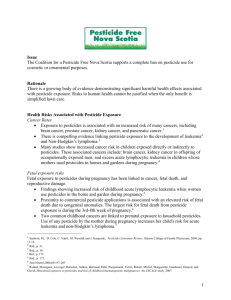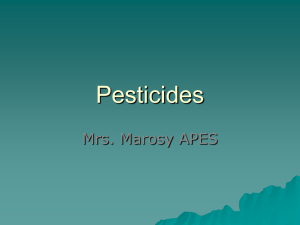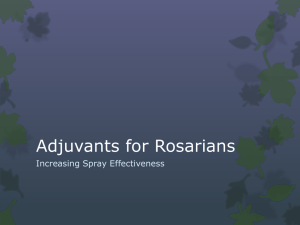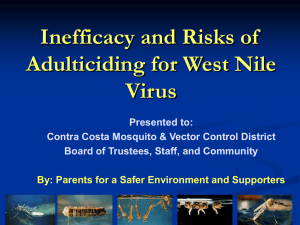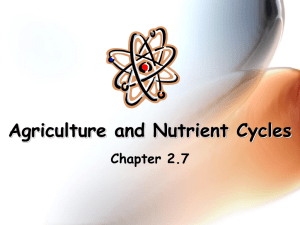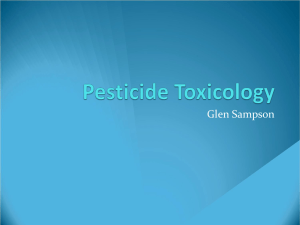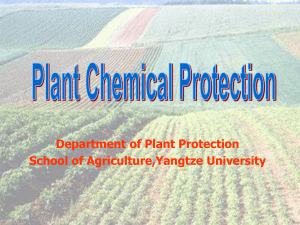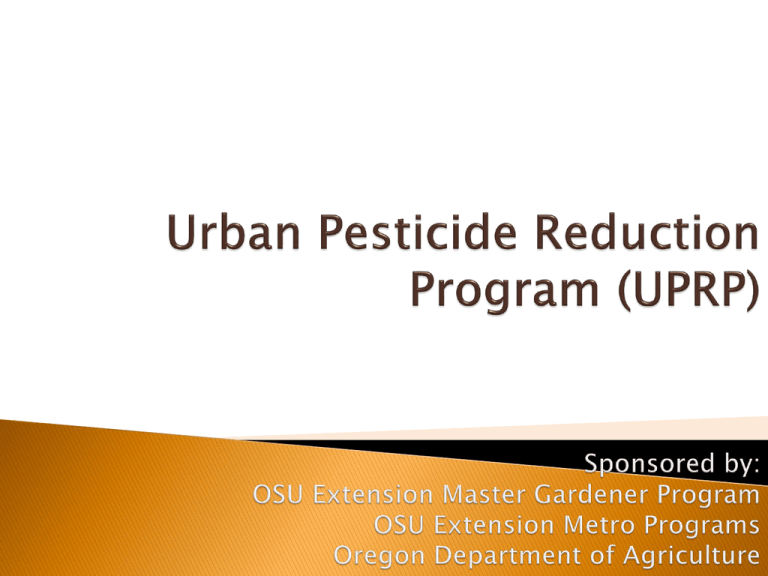
• Introductions
• Review of Last Week’s Class
• Overview of UPRP and Class Surveys (IRB)
• Environmental and Human Health Impacts of Pesticides
• What is a Pesticide?
• Plan for Next Two Weeks
• Three classes
• Class 1:
Overview of UPRP. Pesticides defined.
Assess your pesticide use in the home, garden
and lawn.
• Class 2: Reading a pesticide label. Proper use,
storage and disposal of pesticides.
• Class 3: Environmental fate of pesticides.
Alternatives to pesticides for pest management.
Prevention rather than reaction.
• Toxicity and Risks of
Pesticides
• Reading a Label
• Safe Use, Storage and
Disposal of Pesticides
• Toxicity and Risks of
Pesticides
• Reading a Label
• Safe Use, Storage and
Disposal of Pesticides
• Acute toxicity – damage resulting from a
one-time or limited exposure.
• Chronic toxicity – damage resulting from
long-term (repeated) exposure.
• Cancer
• Birth Defects
• Tumor Growth
• Liver Damage, jaundice, fibrosis, cirrhosis
• Reduces sperm count, miscarriage
• Nerve Damage
• Development of allergies to pesticides or chemicals
in pesticide formulations
• Acute toxicity is usually determined by
animal testing in a dose-response study.
• LOEL = Lowest Observed Effect Level
•
Lowest does with any observable effect.
•
•
Highest dose with no observable effect.
Basis for tolerances (residue levels in food or feed crops).
• NOEL = No Observed Effect Level
• LD50 = “lethal dose fifty”
•
•
•
Dose that killed half of the test animals.
Basis for Signal Words on pesticide labels.
The smaller this number, the more poisonous the
pesticide.
• table salt
• aspirin
• Diazinon
• caffeine
• rotenone
• nicotine
3750 mg/kg
1750 mg/kg
1250 mg/kg
200 mg/kg
130 mg/kg
55 mg/kg
The smaller this number, the more poisonous the substance.
• table salt
• aspirin
• Diazinon
• caffeine
• rotenone
• nicotine
3750 mg/kg = 1.5 to 2 cups
1750 mg/kg = 350 aspirin
1250 mg/kg
200 mg/kg = 160 cups
130 mg/kg
55 mg/kg = 25-55 cigarettes
Symptoms occur at levels far below LD50 values.
Caution
(Cat. IV)
Caution
(Cat. III)
Warning
(Cat. II)
Danger
Danger –
Poison
(Cat. I)
Oral LD50
> 5000 mg/kg
500-5000
mg/kg
50-500 mg/kg
< 50 mg/kg
Inhalation
LD50
Dermal
LD50
> 20 mg/l
2-20 mg/l
0.2-2 mg/l
< 0.2 mg/l
> 5000 mg/kg
2000-5000
mg/kg
200-2000
mg/kg
< 200 mg/kg
Eye Effects No Irritation
Reverses in 7
Days
More than 7
Days
Corrosive
Skin Effects Mild Irritation
Moderate
Irritation
Severe
Irritation
Corrosive
True
False
The signal words ‘DANGER’, ‘CAUTION’ and
‘WARNING’ refer to a pesticide’s potential
hazards to human health
True
False
The signal words ‘DANGER’, ‘CAUTION’ and
‘WARNING’ refer to a pesticide’s potential
hazards to environmental health
• Skin
• Breathing through nose or mouth
• Eyes
• Swallowing
• Once a pesticide enters your
•
body, it doesn’t matter how it got
there!
Symptoms of pesticide poisoning
should be removed from the point
of contact
Mild or early symptoms:
Fatigue
Headache
Dizziness
Blurred vision
Excessive sweating
Excessive salivation
Nausea and vomiting
Stomach cramps
Diarrhea
Tingling or numbness
Moderate symptoms:
Inability to walk
Weakness
Chest discomfort
Muscle twitches
Pupil constriction
Severe symptoms:
Renal Failure
Unconsciousness
Convulsions
Difficulty breathing
Death
Risk = toxicity * exposure
High toxicity * good management = Low risk
Low toxicity * poor management = High risk
Zero exposure = zero risk
• Beware of ANY unusual symptoms!
• Carefully read labels prior to use
•
Know what to expect and how symptoms may be treated
• Pesticide Emergencies
• Poison Control Center: 1-800-222-1222
•
Keep label accessible: EPA registration number
• 911
•
Keep label accessible: EPA registration number
• Toxicity and Risks of
Pesticides
• Reading a Label
• Safe Use, Storage and
Disposal of Pesticides
•
•
•
•
•
•
•
•
•
•
Brand name
Product/Trade name
Chemical name
Ingredient statement
Type of formulation
Net contents
Name and address of manufacturer
Registration number
Establishment number
Precautionary statements
•
•
•
•
•
•
•
•
•
Environmental hazards
Physical & chemical
hazards
Signal words and symbols
Statement of practical
treatment
Directions for use
Preharvest interval
Restricted entry interval
Storage & disposal
directions
Misuse statement
The format of pesticide labels is not standard!
• Never choose or recommend products based
on brand or trade names alone. Read the
active ingredients on the label.
• Several names appear on pesticide labels:
• Brand name (e.g., SevinTM, RoundupTM)
• Common chemical name (e.g., carbaryl)
• Different manufacturers may market the same
active ingredient under different brand names.
• Put in picture of two different products with
same ai
• And put in pics with same looking product
but two different ai’s
• Use the pesticide that you brought from home
for this activity.
• If you do not have a pesticide, you can use the
Ortho Insect Killer Label.
• As a class, we will complete the label activity
worksheet, as we work through the next set of
slides.
http://www.epa.gov/opp00001/label/
•Manufacturer Name
•Trade or Brand Name
Identifies the ‘active ingredient(s)’,
which is/are the ingredient(s)
that control the pest.
Gives the % of other/inert ingredients
These ingredients do not control
the pest, but serves another purpose.
This purpose may be to dissolve
the active ingredient(s) or to
affect how the product works.
Identifies how much pesticide
product is in the container.
•What the product controls
•Where, when and how to use
•Booklet or toll free number may be given for consumers use and information
One of three danger words:
(1) Caution
(2) Warning
(3) Danger or Danger Poison
These words represent the
product’s potential hazards to
humans.
Caution is least hazardous.
Danger Poison is the most hazardous.
•Potential hazards to people
and pets
•Steps you can take to reduce
hazards
•May include information on
how to protect children and/or
pets
If the product is potentially harmful
to wildlife, fish, endangered plants or
animals, or may adversely impact
wetlands and water resources.
Notes hazards such as
Corrosiveness or flammability
•How best to store the product
•What to do with unused product
•What to do with the empty container
What to do if someone swallows,
breathes or contacts the product, or
gets the product on their skin or in
their eyes
A ‘Note to Physicians’, which provides
Drs. with specific information, may
also be included.
EPA Registration Number
EPA Establishment Number
Name, address and sometimes
phone number of the
manufacturer or distributor.
Statement intended to limit a
company’s liability, or to act
as a disclaimer, or to act
as a product warranty.
• What label violations have you seen, or can
you imagine?
• Think about violations in the home and
garden, but also in the workplace.
• Toxicity and Risks of
Pesticides
• Reading a Label
• Safe Use, Storage and
Disposal of Pesticides
**Label will commonly require “longsleeved shirt and long pants” (not
defined as PPE).**
Copyright 2006, Oregon State University, all rights reserved.
Hose End and
Compression Sprayers
Copyright 2006, Oregon State University, all rights reserved.
• Hose-end sprayers are proportioners that mix a
concentrated pesticide with water and emit a
spray of diluted pesticide.
Lid
Container
(Siphon Tube
Inside Container)
• Place anti-siphon device between sprayer and
water source to prevent back siphoning of
pesticides into your water system.
Anti-backflow
device
• Requires extra
precautions due to:
• Breezes
• Splashing
• Pesticides in
concentrated forms
• Require regular
pumping for effective
spray application.
Hand-held
Compression Sprayer
•
Keep pesticides to a minimum, to reduce storage
needs.
•
Follow label instructions.
•
Keep pesticides in original containers!
•
Store in leak-proof containers.
•
Store out of reach of children and pets.
•
Never store near food, feed or medicines.
•
Avoid temperature extremes and moisture.
• Metro operates two household hazardous
waste collection facilities in the Portland area.
• Facility locations, hours of operation
• Metro Recycling Information:
503-234-3000.
• Community collection events in the tricounty-area
• Call 503-234-3000 for information.
• We will be discussing environmental fate of
pesticides and alternatives to pesticides for pest
management.
• Growing Gardens
• Metro Regional Government
• Sustainable Living
• DHS
• OSU Extension Metro Master Gardener Program
• http://flickr.com/photos/judyandpaul/2469337608/
• http://www.audubon.org/bird/at_home/images/IPM
•
_ReducePesticides-12.jpg
http://www.proudtobecanadian.ca/images/pr/Pesticide_stockpile_email.jpg
•
•
•
•
•
•
http://www.phillipmartin.info/clipart/misc_welcome2.gif
http://www.lusd.net/board/agendaClipArt.jpeg
http://www.baileypto.org/
http://www.state.me.us/agriculture/bpc/index.html
http://school.discoveryeducation.com/clipart/images/digtlc
mr.gif
http://www.epa.gov/opp00001/label/




